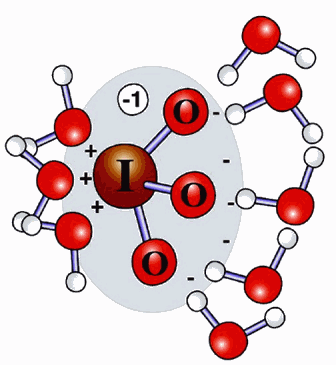Whether creating a catalyst for petroleum-free fuel or designing better drug therapies, scientists need to control ions' actions in water. To do this, the actions must be accurately characterized. A new study by researchers from the U.S. Department of Energy Office of Science’s Pacific Northwest National Laboratory (PNNL) and Argonne National Laboratory, aided by the Advanced Photon Source at Argonne, answers a fundamental question about the behavior of large, negatively charged ions with multiple atoms, called polyoxyanions.
Like a bull in a china shop, a massive, iodine-based ion called “iodate” found within water’s molecular structure should by rights disrupt the surrounding water molecules until it is forcibly expelled.
But it doesn't.
This disconnect between the molecule's attributes and its behavior has puzzled scientists for some time.
Now, the PNNL and Argonne scientists have discovered the secret. Their research has revealed that the iodine atom’s positive nature attracts three water molecules that allow the iodate ion to fit within water’s structure.
While the iodate ion is huge and surrounded by negative oxygen atoms, its central iodine atom takes on a positive character, or becomes a cation. The iodine's cationic behavior strongly attracts the negative oxygen atoms on the three nearby water molecules. By tightly surrounding itself with water, the iodate is able to blend into the water.
“To our knowledge, this is the first time anyone has [achieved] microscopic insight into the solvation of a polyoxyanion,” said Chris Mundy, a physical chemist at PNNL who co-authored the study that appeared in The Journal of Physical Chemistry Letters.
When examining the behavior of large ions in water, the conventional wisdom is that large anions — negatively charged ions, such as iodate (IO3-) — should disrupt the ordered structure of water. For example, iodide (I-) creates cavities within the water and is eventually expelled to the surface.
However, studies assigned iodate as strongly hydrating, meaning it resided in the liquid, not at the surface.
“The puzzle was why iodate did not behave like its slightly smaller cousin, iodide,” said Mundy.
The research team took on that puzzle by integrating computer simulations and experimental studies with iodate. The simulations determined that the central iodine atom is positively charged, even though the ion has a negative charge. The simulations were density-functional-theory-based molecular dynamics simulations run on a powerful computing system, known as NWIce, at the Environmental Molecular Sciences Laboratory at PNNL.
“I would usually expect every water molecule to point a hydrogen at the anion,” said Marcel Baer, of PNNL who worked on the study. “The structure was surprising to me…very unexpected.”
The simulations were confirmed by x-ray absorption fine structure spectroscopy studies carried out at the X-ray Science Division 20-BM beamline at the Advanced Photon Source, where the team used x-rays to examine the structure of the ion in water. This work is one of several such studies carried out by this group at beamline 20-BM, aimed at understanding the solvation structure of ions under ambient as well as super critical conditions. In this particular case, the work involved looking at multiple edges of Iodine ( K, L3, L2 and L1) all of which could be accessed at 20-BM.
“This one is not the same as the pure hydration that would normally be seen with a cation. It has its own structure,” said Van-Thai Pham, a postdoctoral researcher at PNNL who worked on the spectroscopy investigations at the light source.
The researchers are further delving into the mysteries of iodate. The team is looking into the water surface to see if iodate is absorbed or if the water shell that is formed rejects the ion at the surface. In addition, team members are studying how other ions behave in water. They are focusing on ions based on positively charged cesium, bromide, and rubidium. A better understanding of these ions and others has implications for applications from alternative energy sources to new drug therapies.
See: Marcel D. Baer1, Van-Thai Pham1, John L. Fulton1*, Gregory K. Schenter1**, Mahalingam Balasubramanian2, and Christopher J. Mundy1***, “Is Iodate a Strongly Hydrated Cation?,” J. Phys. Chem. Lett. 2, 2650 (2011). DOI: 10.1021/jz2011435
Author affiliations: 1Pacific Northwest National Laboratory, 2Argonne National Laboratory
Correspondence:***[email protected], **[email protected],
This work was supported by the U.S. Department of Energy’s (DOE’s) Office of Basic Energy Sciences, Division of Chemical Sciences, Geosciences and Biosciences. PNNL is operated for the Department of Energy by Battelle. Use of the Advanced Photon Source was supported by the DOE Office of Science under Contract No. DE-AC02-06CH11357).
Based on a press release from Pacific Northwest National Laboratory (news : web)
The Advanced Photon Source at Argonne National Laboratory is one of five national synchrotron radiation light sources supported by the U.S. Department of Energy’s Office of Science to carry out applied and basic research to understand, predict, and ultimately control matter and energy at the electronic, atomic, and molecular levels, provide the foundations for new energy technologies, and support DOE missions in energy, environment, and national security. To learn more about the Office of Science x-ray user facilities, visit http://science.energy.gov/user-facilities/basic-energy-sciences/.
Argonne National Laboratory seeks solutions to pressing national problems in science and technology. The nation's first national laboratory, Argonne conducts leading-edge basic and applied scientific research in virtually every scientific discipline. Argonne researchers work closely with researchers from hundreds of companies, universities, and federal, state and municipal agencies to help them solve their specific problems, advance America's scientific leadership and prepare the nation for a better future. With employees from more than 60 nations, Argonne is managed by UChicago Argonne, LLC for the U.S. Department of Energy's Office of Science.

